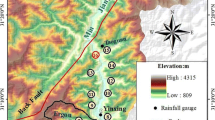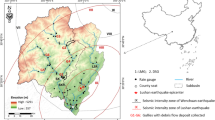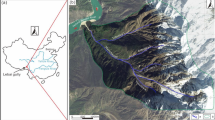Abstract
The paper reports on debris flows in the Tungmen and Hoser areas of Taiwan, triggered by Typhoon Ofelia on 23 June 1990 and Typhoon Herb at the end of July 1996 respectively. The intense rainfall resulted in large volumes of debris being eroded from the valleys. The village of Tungmen was almost totally destroyed by in excess of 100,000 m3 of material which was moved by the 1990 debris flow while the 1996 typhoon was responsible for the movement of almost 1.5 million m3 of material, 80% of which extended to the confluence area of the two side gullies and the Hoser River. Attention is drawn to the change in shape of the valley sides from generally V-shaped prior to the debris flow to U-shaped following the storms. A comparison of aerial photographs as well as field data was used to define the main topographical effects of the 1990 storm (Tungmen) and 1996 event (Hoser). A study of the discontinuity pattern within the valleys emphasised the significance of toppling and gravity slumping of material in the sides of the valleys in producing large quantities of debris which, in heavy storm conditions, can flow down the gullies. Laboratory tests were used to simulate the effect of saturation on the materials. These indicated that in their saturated state they would easily become unstable.
Résumé
L'article présente des laves torrentielles qui se sont produites dans les régions de Tungmen et de Hoser à Taïwan, déclenchées respectivement par le typhon Ofelia le 23 juin 1990 et le typhon Herb à la fin juillet 1996. Les pluies intenses ont provoqué l'érosion d'importants volumes de formations de pentes sur les versants. Le village de Tungmen fut presque totalement détruit par plus de 100.000 m3 de matériaux transportés par la lave torrentielle de 1990, tandis que le typhon de 1996 a mobilisé près de 1,5 million de m3 de matériaux, 80% de ce volume atteignant la zone de confluence de deux ravines avec la rivière Hoser. L'attention est attirée sur le changement de profil des versants, généralement en V avant les laves torrentielles, en U après ces événements. Une comparaison de photographies aériennes ainsi que des reconnaissances de terrain ont permis de définir les principaux effets sur la topographie des orages de 1990 (Tungmen) et de 1996 (Hoser). Une étude des systèmes de discontinuités affectant les versants a permis de souligner l'importance des phénomènes de basculement et de glissement sur les versants apportant de grandes quantités de débris qui, en cas de violent orage, peuvent s'écouler le long des ravines. Des essais de laboratoire ont permis de simuler l'effet de la saturation sur ces matériaux et de montrer leur grande mobilité en cas de saturation.
Similar content being viewed by others

Author information
Authors and Affiliations
Additional information
Received: 1 December 1999 · Accepted: 11 January 2000
Rights and permissions
About this article
Cite this article
Chen, H. The geomorphological comparison of two debris flows and their triggering mechanisms. Bull Eng Geol Env 58, 297–308 (2000). https://doi.org/10.1007/s100640000042
Issue Date:
DOI: https://doi.org/10.1007/s100640000042



